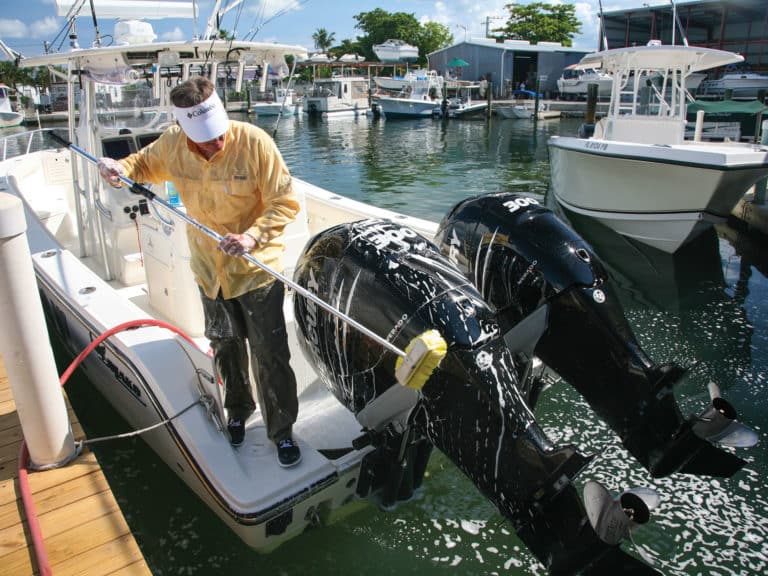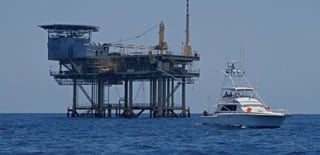
| Deep-water oil and gas rigs throughout the Gulf can provide wahoo anglers with great opportunities on days when the water is clear. |
Big shark!” yelled Steve Shook, leaning over the side of the 36-foot Contender. “And he’s right behind your wahoo! Reel, reel, reel!”
Lauren Richoux was hooked up to a huge ‘hoo in the 80-pound class that had just about worn her out. Now, with the battle almost over, a large, aggressive mako shark was complicating matters.
Suddenly, the wahoo rushed the boat and rocketed past before Kyle Thorsen could stick it with the ten-foot gaff. Summoning her remaining energy, Richoux leaned hard against the rod, tightened the drag and turned the fish. As the wahoo came alongside, Thorsen laid the gaff across the its back – but not before the mako shot forward and neatly clipped off its tail. The rudderless ‘hoo was hauled over the gunwale and into the cockpit, where it proceeded to spray blood over everyone.
Talk about chaos – and it only got wilder, as wahoo after wahoo continued to assault our live baits. We were 40 miles off Port Fourchon, Louisiana, bump-trolling blue runners around an oil and gas production platform in 200 feet of water. Seas were lumpy three-to-fives, which had almost caused us to cancel the trip. Good thing we hadn’t, as what might have been a blowout turned out to be one of the best days of wahoo fishing I had ever experienced!
Hit the Rigs
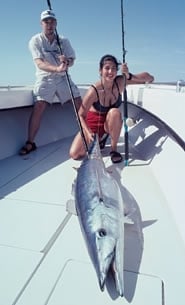
Kyle Thorsen, left, keeps Lauren Richoux’s tail-less wahoo pinned to the deck with his gaff after they managed to take the hooked fish from a marauding mako.|
Not only are wahoo one of the tastiest fish in the Gulf, they are also one of the most unpredictable. You never know when they’ll show up, which is why most ‘hoos are taken incidentally on trolling gear. However, in the past few years a cadre of dedicated anglers has discovered that bump-trolling or even casting live baits to cruising fish around offshore structure can be a very productive way to target them.
Wahoo can be found around weed lines and current rips, but the best place to look for them is around the numerous oil and gas rigs off the coast of Louisiana and Texas. The deep rigs in 400 to 3,000 feet of water usually hold the most ‘hoo, although I’ve caught them as shallow as 30 feet. The real key is water clarity. Wahoo don’t like cloudy or green water, but they do like it rough. The fish aren’t nearly as spooky when seas are choppy and they can use the wave troughs to ambush prey near the surface. On the other hand, I’ve also seen schools of wahoo working on top in dead-calm conditions.
A few years back, some buddies and I were trolling artificials around the Cerveza Rig, about 95 miles out of Galveston, Texas. The seas were slick, it was hot as hell and we couldn’t buy a bite. I was up in the tower when I noticed a pack of wahoo darting in and out of the spread. We tried everything to get those fish to eat, but they didn’t want any of our lures. So we shut down, pulled our lines and began rigging some hardtails we had in the live well. Meanwhile, the wahoo continued to swim around the boat. As soon as those hardtails hit the water, the wahoo hammered them!
Wahoo on Shrimp?
Wahoo are opportunistic feeders that will eat just about anything that won’t eat them first, but that’s not to say they can’t be picky. Without a doubt, the best bait is a live hardtail, or blue runner; however, pogies (menhaden), croakers, mullet, pinfish (perch) and even shrimp work well at times.
| ### Superb How-To Book |
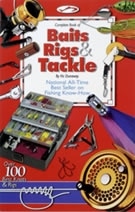
Vic Dunaway’s Complete Book of Baits, Rigs & Tackle was first published over 30 years ago and has since been updated and revised 13 times. The 2003 edition is by far the best yet, chock full of rigs, baits, lures, knots, wire wraps, tackle, accessories and helpful advice, much of which is brand new. Although there is some fresh water info, the book primarily deals with salt, from fly to offshore, with loads on light tackle. It’s been redesigned with hundreds of full-color photos and detailed illustrations. If you were to own just one how-to reference book on rigs and baits, this might be it.Dunaway, as many readers already know, was the long-time Editor (and now Senior Editor) of Florida Sportsman magazine, is the author of a number of successful books on fishing – and even penned a few articles for SWS way back when. Complete Book of Baits, Rigs & Tackle is perhaps his largest-selling and “signature” work, and our recommendation is: Buy a copy. Softcover, 256 pages, $16.95, available by calling (877) 725-8987.|
Last summer, a friend and I were fishing a rock formation in 200 feet of water off Port Mansfield, Texas, when we spotted two wahoo near the surface. They wouldn’t hit a thing, including jigs and silver spoons. The only live baits we had onboard were shrimp, big shrimp, so I rigged one on a 2/0 hook and free-lined it behind the boat. Moments later a wahoo appeared, swam up to the shrimp and kind of slurped it up. You never know what a wahoo will want.
No one knows this better than Texas charter captain Tommy Gueldner, who has been putting clients on wahoo for years. “At times you can find wahoo bunched up along weed lines and tidal rips,” says Gueldner. “That’s when they can be easily caught on live baits. My favorite is a hand-sized perch (pinfish). I’ll rig it on a short wire leader, about three feet long. If the water is very clear and calm, I’ll go with a shorter leader. A three-foot, 100-pound-test leader is usually best, and a 7/0 live-bait hook is perfect for perch. You can hook them through the back, lips, eyes or nostrils.”
Another top wahoo bait is flying fish, which Gueldner catches under the boat lights at night with a dipnet or castnet. Mullet also work, and can be caught by throwing a castnet along the jetties on the way offshore. Like croakers and pinfish, mullet are hardy baits. Wahoo aren’t crazy about them, but will eat them if there’s nothing else around. In any event, it’s always a good idea to catch a few mullet, croakers and pinfish just in case you can’t find any hardtails.
Rigging Hardtails
Fortunately, it’s usually easy to catch hardtails on the offshore grounds. Throughout the summer you’ll find them around the legs of most oil and gas platforms, where they’ll readily hit small jigs and Sabiki rigs. The smaller hardtails – five- to eight-inchers – can be caught around rigs in 30 to 50 feet of water. Larger hardtails can be jigged up around the deep-water rigs.
Steve Shook rigs his hardtails with a tandem-hook setup consisting of an Owner 1/0 live-bait hook connected to a No. 1 VMC treble. The hooks are rigged about six inches apart, and are connected with No. 7 stainless wire. The live-bait hook is run through the bait’s nostrils, while the treble is inserted just below the dorsal fin. Shook attaches a three-foot section of 30- to 40-pound-test Terminator titanium wire leader to the tandem rig. The flexible titanium is tied to a loop in the stainless wire with a clinch knot.
| ### For informationabout fishing with Tommy Gueldner out of Port Aransas, Texas, call him at (361) 749-6055. |
Regardless of which live baits you use, the best tactic is to bump-troll them around the rigs. Once the baits have been deployed, put the boat in gear and idle forward for a minute or so, then take it out of gear. This moves the baits up and down in the water column and keeps them out of the props. It’s a good way to cover a lot of water and various depths.
Another option is to cast live baits to any wahoo that happen to show near the surface. Of course, that kind of exciting opportunity doesn’t present itself on every trip out, but you never know. If you spend a good deal of time in the Gulf, you learn to expect the unexpected – especially where wahoo are concerned.
SWS Texas Regional Editor Robert Sloan reports regularly on Gulf Coast fishing. He is also the outdoor columnist for the Beaumont Daily News. – Ed.
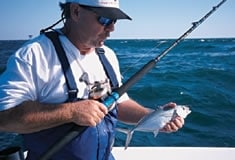
|1. Steve Shook prepares to deploy a rigged hardtail, considered by many pros to be the best bait for wahoo.|
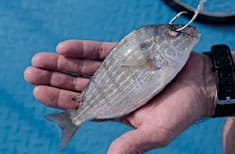
|** 2.** Pinfish are hardy baits that can be hooked through the eyes, back, lips or nostrils.|
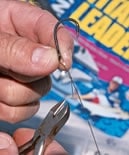
|3. Rigging hooks with stainless or titanium wire will prevent toothy wahoo from parting the line.|
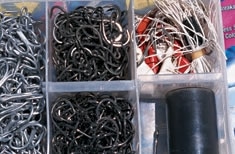
|4. Top skippers carry a wide selection of hooks to transform their live baits into irresistible wahoo weapons.|
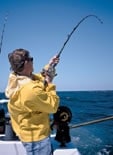
|5. Wahoo often bite best when it’s rough and windy.|








